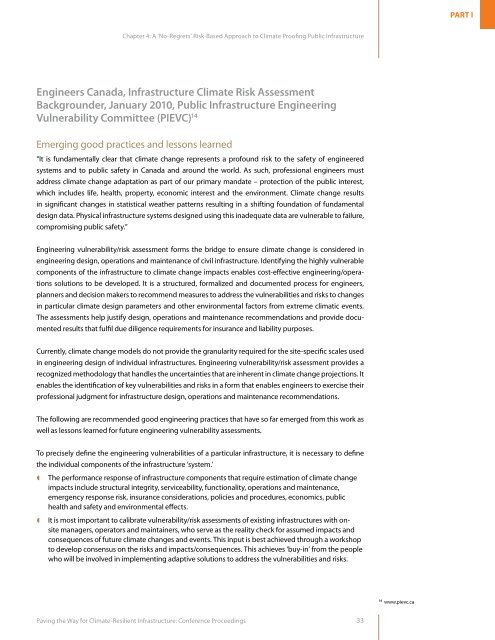Paving the Way for Climate-Resilient Infrastructure - UN CC:Learn
Paving the Way for Climate-Resilient Infrastructure - UN CC:Learn
Paving the Way for Climate-Resilient Infrastructure - UN CC:Learn
You also want an ePaper? Increase the reach of your titles
YUMPU automatically turns print PDFs into web optimized ePapers that Google loves.
PART IChapter 4: A ‘No-Regrets’ Risk-Based Approach to <strong>Climate</strong> Proofing Public <strong>Infrastructure</strong>Engineers Canada, <strong>Infrastructure</strong> <strong>Climate</strong> Risk AssessmentBackgrounder, January 2010, Public <strong>Infrastructure</strong> EngineeringVulnerability Committee (PIEVC) 14Emerging good practices and lessons learned“It is fundamentally clear that climate change represents a profound risk to <strong>the</strong> safety of engineeredsystems and to public safety in Canada and around <strong>the</strong> world. As such, professional engineers mustaddress climate change adaptation as part of our primary mandate – protection of <strong>the</strong> public interest,which includes life, health, property, economic interest and <strong>the</strong> environment. <strong>Climate</strong> change resultsin significant changes in statistical wea<strong>the</strong>r patterns resulting in a shifting foundation of fundamentaldesign data. Physical infrastructure systems designed using this inadequate data are vulnerable to failure,compromising public safety.”Engineering vulnerability/risk assessment <strong>for</strong>ms <strong>the</strong> bridge to ensure climate change is considered inengineering design, operations and maintenance of civil infrastructure. Identifying <strong>the</strong> highly vulnerablecomponents of <strong>the</strong> infrastructure to climate change impacts enables cost-effective engineering/operationssolutions to be developed. It is a structured, <strong>for</strong>malized and documented process <strong>for</strong> engineers,planners and decision makers to recommend measures to address <strong>the</strong> vulnerabilities and risks to changesin particular climate design parameters and o<strong>the</strong>r environmental factors from extreme climatic events.The assessments help justify design, operations and maintenance recommendations and provide documentedresults that fulfil due diligence requirements <strong>for</strong> insurance and liability purposes.Currently, climate change models do not provide <strong>the</strong> granularity required <strong>for</strong> <strong>the</strong> site-specific scales usedin engineering design of individual infrastructures. Engineering vulnerability/risk assessment provides arecognized methodology that handles <strong>the</strong> uncertainties that are inherent in climate change projections. Itenables <strong>the</strong> identification of key vulnerabilities and risks in a <strong>for</strong>m that enables engineers to exercise <strong>the</strong>irprofessional judgment <strong>for</strong> infrastructure design, operations and maintenance recommendations.The following are recommended good engineering practices that have so far emerged from this work aswell as lessons learned <strong>for</strong> future engineering vulnerability assessments.To precisely define <strong>the</strong> engineering vulnerabilities of a particular infrastructure, it is necessary to define<strong>the</strong> individual components of <strong>the</strong> infrastructure ‘system.’The per<strong>for</strong>mance response of infrastructure components that require estimation of climate changeimpacts include structural integrity, serviceability, functionality, operations and maintenance,emergency response risk, insurance considerations, policies and procedures, economics, publichealth and safety and environmental effects.It is most important to calibrate vulnerability/risk assessments of existing infrastructures with onsitemanagers, operators and maintainers, who serve as <strong>the</strong> reality check <strong>for</strong> assumed impacts andconsequences of future climate changes and events. This input is best achieved through a workshopto develop consensus on <strong>the</strong> risks and impacts/consequences. This achieves ‘buy-in’ from <strong>the</strong> peoplewho will be involved in implementing adaptive solutions to address <strong>the</strong> vulnerabilities and risks.14www.pievc.ca<strong>Paving</strong> <strong>the</strong> <strong>Way</strong> <strong>for</strong> <strong>Climate</strong>-<strong>Resilient</strong> <strong>Infrastructure</strong>: Conference Proceedings 33
















